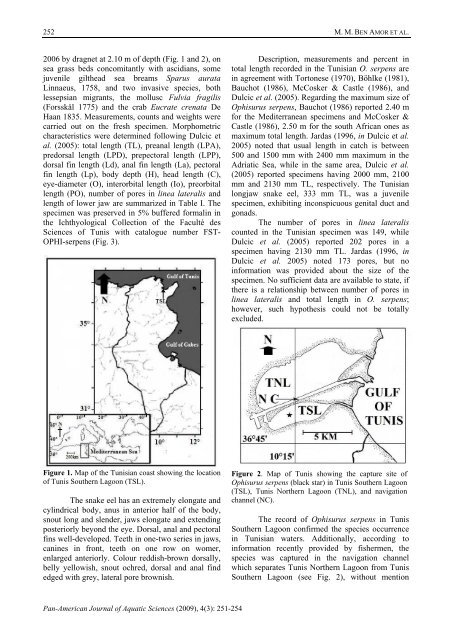Download full issue - PanamJAS
Download full issue - PanamJAS
Download full issue - PanamJAS
You also want an ePaper? Increase the reach of your titles
YUMPU automatically turns print PDFs into web optimized ePapers that Google loves.
252<br />
M. M. BEN AMOR ET AL.<br />
2006 by dragnet at 2.10 m of depth (Fig. 1 and 2), on<br />
sea grass beds concomitantly with ascidians, some<br />
juvenile gilthead sea breams Sparus aurata<br />
Linnaeus, 1758, and two invasive species, both<br />
lessepsian migrants, the mollusc Fulvia fragilis<br />
(Forsskål 1775) and the crab Eucrate crenata De<br />
Haan 1835. Measurements, counts and weights were<br />
carried out on the fresh specimen. Morphometric<br />
characteristics were determined following Dulcic et<br />
al. (2005): total length (TL), preanal length (LPA),<br />
predorsal length (LPD), prepectoral length (LPP),<br />
dorsal fin length (Ld), anal fin length (La), pectoral<br />
fin length (Lp), body depth (H), head length (C),<br />
eye-diameter (O), interorbital length (Io), preorbital<br />
length (PO), number of pores in linea lateralis and<br />
length of lower jaw are summarized in Table I. The<br />
specimen was preserved in 5% buffered formalin in<br />
the Ichthyological Collection of the Faculté des<br />
Sciences of Tunis with catalogue number FST-<br />
OPHI-serpens (Fig. 3).<br />
Description, measurements and percent in<br />
total length recorded in the Tunisian O. serpens are<br />
in agreement with Tortonese (1970), Böhlke (1981),<br />
Bauchot (1986), McCosker & Castle (1986), and<br />
Dulcic et al. (2005). Regarding the maximum size of<br />
Ophisurus serpens, Bauchot (1986) reported 2.40 m<br />
for the Mediterranean specimens and McCosker &<br />
Castle (1986), 2.50 m for the south African ones as<br />
maximum total length. Jardas (1996, in Dulcic et al.<br />
2005) noted that usual length in catch is between<br />
500 and 1500 mm with 2400 mm maximum in the<br />
Adriatic Sea, while in the same area, Dulcic et al.<br />
(2005) reported specimens having 2000 mm, 2100<br />
mm and 2130 mm TL, respectively. The Tunisian<br />
longjaw snake eel, 333 mm TL, was a juvenile<br />
specimen, exhibiting inconspicuous genital duct and<br />
gonads.<br />
The number of pores in linea lateralis<br />
counted in the Tunisian specimen was 149, while<br />
Dulcic et al. (2005) reported 202 pores in a<br />
specimen having 2130 mm TL. Jardas (1996, in<br />
Dulcic et al. 2005) noted 173 pores, but no<br />
information was provided about the size of the<br />
specimen. No sufficient data are available to state, if<br />
there is a relationship between number of pores in<br />
linea lateralis and total length in O. serpens;<br />
however, such hypothesis could not be totally<br />
excluded.<br />
Figure 1. Map of the Tunisian coast showing the location<br />
of Tunis Southern Lagoon (TSL).<br />
The snake eel has an extremely elongate and<br />
cylindrical body, anus in anterior half of the body,<br />
snout long and slender, jaws elongate and extending<br />
posteriorly beyond the eye. Dorsal, anal and pectoral<br />
fins well-developed. Teeth in one-two series in jaws,<br />
canines in front, teeth on one row on womer,<br />
enlarged anteriorly. Colour reddish-brown dorsally,<br />
belly yellowish, snout ochred, dorsal and anal find<br />
edged with grey, lateral pore brownish.<br />
Figure 2. Map of Tunis showing the capture site of<br />
Ophisurus serpens (black star) in Tunis Southern Lagoon<br />
(TSL), Tunis Northern Lagoon (TNL), and navigation<br />
channel (NC).<br />
The record of Ophisurus serpens in Tunis<br />
Southern Lagoon confirmed the species occurrence<br />
in Tunisian waters. Additionally, according to<br />
information recently provided by fishermen, the<br />
species was captured in the navigation channel<br />
which separates Tunis Northern Lagoon from Tunis<br />
Southern Lagoon (see Fig. 2), without mention<br />
Pan-American Journal of Aquatic Sciences (2009), 4(3): 251-254
















